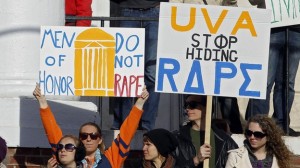Sexual assault occurs daily on college campuses yet goes unreported and uninvestigated. Women represent the group most affected by assault at colleges. Carly Smith, Jennifer Freyd, and Travis Pratt seek to explain this phenomenon. Smith and Freyd discuss sexual assault in terms of the institutions that betray their students by failing to advocate for and protect them.33 Pratt outlines how male dominated domains and a lack of self-control contribute to assault.34 Together, the two offer an explanation for the frequency of sexual assault on urban, college campuses.
Arguably the two largest contributors and perpetuators of sexual assault on campuses are a lack of administrative support and man’s perception of a right to a woman’s bodies. Male-dominated spaces such as fraternities or athletic teams are more likely than co-ed spaces to succumb to male peer support. This is a type of group norm in which men accept a certain behavior, regardless of its legality or morality, as good/bad depending on the group. As Pratt explains, “These kinds of supports may provide men with the confidence and encouragement that dealing with women in abusive ways is socially appropriate according to group norms.”35 These male-dominated groups often take part in heavy drinking, sexual objectification of women, group secrecy, and hyper-masculinity, which all are indirect influences of sexual assault. Finally, a lack of self-control on the part of male-dominated groups directly contributes to the prevalence of sexual assault. While sexual assault is more likely to occur in male dominated spaces, it is “the lenient treatment typically afforded to fraternities and athletic teams by university administrators when handling and citing these organizations who are involved in sexually assaultive incidents”36 that perpetuates the issue.
While sexual assault is more likely to occur in male dominated spaces, it is “the lenient treatment typically afforded to fraternities and athletic teams by university administrators when handling and citing these organizations who are involved in sexually assaultive incidents”36 that perpetuates the issue.
While male-peer support is a cause of sexual violence, a lack of administrative response sustains sexual assault on college campuses. Smith and Freyd explain insitutional betrayal through Lizzy’s story. Lizzy was raped at Notre Dame and did not receive support from the institution, her peers, or the justice system. Ultimately, Lizzy committed suicide as a result of her assault. As Smith and Freyd explain, “Institutions (e.g., work-places, schools, religious organizations) have the potential to either worsen post-traumatic outcomes or become sources of justice, support, and healing.”37  In regards to assault, schools often fail to be a source of “justice, support, and healing” and betray a promise to protect their students. Students form a personal relationship with their school much like they do with friends or family. When that institution fails to support its students, it can cause a student to experience a betrayal trauma, which is “associated with higher rates of a host of outcomes, including post-taumatic stress disorder, dissociation, anxiety, depression, and borderline personality disorder.”38 Because institutions fear what acknowledging sexual assault will mean for their reputation, they fail to put forth the proper protocol for helping a survivor and often resort to tactics such as victim shaming or cover-ups in order to save face.39
In regards to assault, schools often fail to be a source of “justice, support, and healing” and betray a promise to protect their students. Students form a personal relationship with their school much like they do with friends or family. When that institution fails to support its students, it can cause a student to experience a betrayal trauma, which is “associated with higher rates of a host of outcomes, including post-taumatic stress disorder, dissociation, anxiety, depression, and borderline personality disorder.”38 Because institutions fear what acknowledging sexual assault will mean for their reputation, they fail to put forth the proper protocol for helping a survivor and often resort to tactics such as victim shaming or cover-ups in order to save face.39
Images taken from:
(in order of appearance)
http://www.bbc.com/news/blogs-echochambers-30153441
http://thinkprogress.org/health/2013/08/06/2420451/activists-launch-know-your-title-ix/
